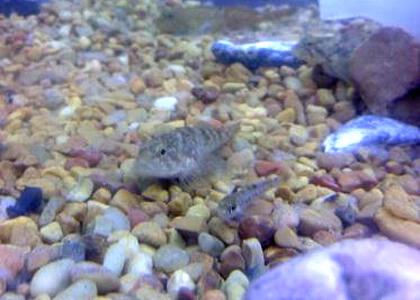Lake trout (Salvelinus namaycush) were extinct in Lake Champlain by 1900 (Marsden and Langdon 2012). Causes of their disappearance and decline in Lake Champlain are relatively unknown. Lake trout have significant economic, ecological, and recreational importance, and restoration efforts began with stocking fingerlings and yearlings in 1973 (Marsden et al. 2010). Stocking efforts have had limited success due to a lack of recruitment. Spawning by stocked lake trout occurs in Lake Champlain and most of the Great Lakes. High egg and fry abundances have been recorded, but recruitment to age-1 and older has been unsuccessful (Marsden et al. 2005). The lack of natural reproductive success of lake trout has been a focus of models based on interstitial predation of lake trout eggs (Fitzsimons et al. 2006).
Lake trout deposit their eggs on rocky reefs, where they are protected from waves and most predators; however, they are vulnerable to interstitial predators, including crayfish (Orconectes propinquus), slimy sculpin (Cottus cognatus), and mottled sculpin (C. bairdi) which are able to penetrate deep into rocky substrates (Biga et al. 1998). Slimy sculpin are a benthic fish species found in cold water lakes and streams across North America (Langdon et al. 2006) (Fig. 1). Slimy sculpin are known predators of lake trout eggs in interstitial spaces on natural and artificial reefs. Slimy sculpin have frequently been observed in emergent fry traps in which the opening to the trap is considerably smaller than the head width of the sculpin (J. E. Marsden, personal observation). This observation leads to the assumption that sculpin can deform the shape of their head in order to penetrate interstitial spaces, particularly to acquire prey. The purpose of this study was to quantify the degree to which slimy sculpin can deform their heads by measuring the smallest opening that an individual fish can enter.
To test the abilities of sculpin to enter areas smaller than their head, A ‘tunnel trap’ was created with funnels of decreasing diameters (25.4 mm, 22.2 mm, 19.1 mm, 15.9 mm, 12.7 mm, 9.5 mm, 6.4 mm, and 3.2 mm) (Fig. 2). ). A 150-L aquarium was partitioned, with the tunnel mounted in the partition, allowing entrance to the tunnel on one side only. After a three-day period, sculpin were removed from each section of the tunnel and the compartment in which sculpin were found was recorded. Total length (mm) and maximum horizontal and vertical width (mm) dimensions were measured for each sculpin.
We tested a total of 75 sculpin; 28 (37%) entered spaces smaller than the maximum width of their head. The maximum head shrinkage observed was 19.7%. Results indicate that slimy sculpin have the ability to maneuver into interstitial spaces smaller than their head, allowing them to enter areas that are refuge for lake trout fry and eggs. With lake trout restoration as a high priority of most Great Lake fisheries, information about the capabilities of egg and larval predators is useful for estimating and modeling the impact of interstitial predators.

Laboratory investigations of slimy sculpin (Cottus cognatus) ability to penetrate small holes by head deformation
Harrison Tobi
ShareJuly 22, 2013